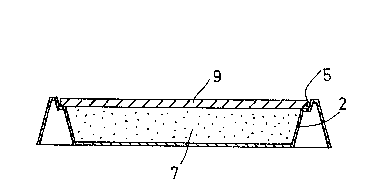Some of the information on this Web page has been provided by external sources. The Government of Canada is not responsible for the accuracy, reliability or currency of the information supplied by external sources. Users wishing to rely upon this information should consult directly with the source of the information. Content provided by external sources is not subject to official languages, privacy and accessibility requirements.
Any discrepancies in the text and image of the Claims and Abstract are due to differing posting times. Text of the Claims and Abstract are posted:
| (12) Patent Application: | (11) CA 2082597 |
|---|---|
| (54) English Title: | DISH FOR PRODUCING A FOOD PRODUCT CONSISTING OF A BASE AND FILLING, A PROCESS FOR THE PRODUCTION OF THE FOOD PRODUCT AND THE FINAL PRODUCT OBTAINED |
| (54) French Title: | CONTENANT POUR LA PRODUCTION D'UN PRODUIT ALIMENTAIRE COMPOSE D'UNE BASE ET D'UNE GARNITURE, PROCEDE DE FABRICATION DU PRODUIT ALIMENTAIRE ET PRODUIT ALIMENTAIRE OBTENU |
| Status: | Deemed Abandoned and Beyond the Period of Reinstatement - Pending Response to Notice of Disregarded Communication |
| (51) International Patent Classification (IPC): |
|
|---|---|
| (72) Inventors : |
|
| (73) Owners : |
|
| (71) Applicants : |
|
| (74) Agent: | BORDEN LADNER GERVAIS LLP |
| (74) Associate agent: | |
| (45) Issued: | |
| (22) Filed Date: | 1992-11-10 |
| (41) Open to Public Inspection: | 1993-05-12 |
| Examination requested: | 1993-03-31 |
| Availability of licence: | N/A |
| Dedicated to the Public: | N/A |
| (25) Language of filing: | English |
| Patent Cooperation Treaty (PCT): | No |
|---|
| (30) Application Priority Data: | ||||||
|---|---|---|---|---|---|---|
|
ABSTRACT
Dish for producing a food product consisting of a base
and filling, a process for the production of the food
product and the final product obtained
To produce a food product consisting of an edible dough
base and a filling, the filling is disposed in a dish,
the lateral wall of which has, at its top part, a first
bottom flange and a second top flange, until it reaches
the level of the bottom flange. A sheet of edible dough
is then placed on top of the dish and cut by stamping
against the top flange, thus producing the base of the
food product.
Fig 3
Note: Claims are shown in the official language in which they were submitted.
Note: Descriptions are shown in the official language in which they were submitted.

2024-08-01:As part of the Next Generation Patents (NGP) transition, the Canadian Patents Database (CPD) now contains a more detailed Event History, which replicates the Event Log of our new back-office solution.
Please note that "Inactive:" events refers to events no longer in use in our new back-office solution.
For a clearer understanding of the status of the application/patent presented on this page, the site Disclaimer , as well as the definitions for Patent , Event History , Maintenance Fee and Payment History should be consulted.
| Description | Date |
|---|---|
| Inactive: IPC expired | 2017-01-01 |
| Inactive: IPC from MCD | 2006-03-11 |
| Inactive: IPC from MCD | 2006-03-11 |
| Time Limit for Reversal Expired | 1997-11-10 |
| Application Not Reinstated by Deadline | 1997-11-10 |
| Deemed Abandoned - Failure to Respond to Maintenance Fee Notice | 1996-11-11 |
| Application Published (Open to Public Inspection) | 1993-05-12 |
| Request for Examination Requirements Determined Compliant | 1993-03-31 |
| All Requirements for Examination Determined Compliant | 1993-03-31 |
| Abandonment Date | Reason | Reinstatement Date |
|---|---|---|
| 1996-11-11 |
Note: Records showing the ownership history in alphabetical order.
| Current Owners on Record |
|---|
| FRISCO-FINDUS AG |
| Past Owners on Record |
|---|
| ALAIN GUEROULT |